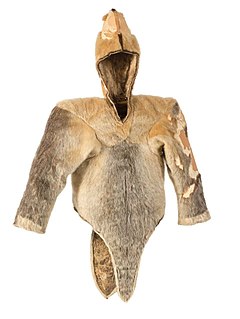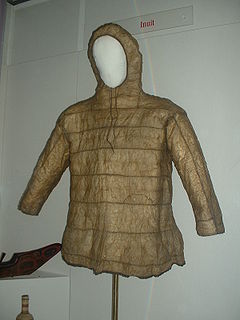 W
WTraditional Inuit clothing is a complex system of cold-weather garments historically made from animal hide and fur, worn by the Inuit, a group of culturally related indigenous peoples inhabiting the Arctic areas of the United States, Canada, and Greenland. The basic outfit consisted of a parka, pants, mittens, inner footwear, and outer boots. The most common sources of hide were caribou, seals, and seabirds, although other animals were used when available. The production of warm, durable clothing was an essential survival skill which was passed down from adult women to girls, and which could take years to master. Preparation of clothing was an intensive, weeks-long process that occurred on a yearly cycle following established hunting seasons. The creation and use of skin clothing was strongly intertwined with Inuit religious beliefs.
 W
WThe amauti is the parka worn by Inuit women of the eastern area of Northern Canada. Up until about two years of age, the child nestles against the mother's back in the amaut, the built-in baby pouch just below the hood. The pouch is large and comfortable for the baby. The mother can bring the child from back to front for breastfeeding or for eliminatory functions without exposure to the elements. This traditional eastern Arctic Inuit parka, designed to keep the child warm and safe from frostbite, wind and cold, also helps to develop bonding between mother and child.
 W
WArchaeological evidence indicates that the history of Inuit clothing extends far back into prehistory, with significant evidence to indicate that the basic structure of Inuit clothing has changed little since. The clothing systems of all Arctic peoples are similar, and evidence in the form of tools and carved figurines indicates that these systems may have originated in Siberia as early as 22,000 BCE, and in northern Canada and Greenland as early as 2500 BCE. Pieces of garments found at archaeological sites, dated to approximately 1000 to 1600 CE, are very similar to garments from the 17th to mid-20th centuries, which confirms consistency in the construction of Inuit clothing over centuries.
 W
WA kamleika is an Aleut robe made from sea mammal intestine, which was light and waterproof. They also sometimes had robes to protect against threats such as heavy wind and rain. They were sewn with grass, and each took around a month to make.
 W
WA kuspuk is a hooded overshirt with a large front pocket commonly worn among Alaska Natives. Kuspuks are tunic-length, falling anywhere from below the hips to below the knees. The bottom portion of kuspuks worn by women may be gathered and akin to a skirt. Kuspuks tend to be pullover garments, though some have zippers.
 W
WMukluks or kamik are a soft boot, traditionally made of reindeer (caribou) skin or sealskin, and worn by Arctic aboriginal people, including the Inuit, Iñupiat, and Yupik.
 W
WA parka or anorak is a type of coat with a hood, often lined with fur or faux fur. The Caribou Inuit invented this kind of garment, originally made from caribou or seal skin, for hunting and kayaking in the frigid Arctic. Some Inuit anoraks require regular coating with fish oil to retain their water resistance.
 W
WThere is a long historical tradition of research on Inuit clothing across many fields. Since Europeans first made contact with the Inuit in the 16th century, documentation and research on Inuit clothing has included artistic depictions, academic writing, studies of effectiveness, and museum collections. Historically, European images of Inuit people were sourced from the clothing worn by Inuit who travelled to Europe, clothing brought to museums by explorers, and from written accounts of travels to the Arctic.
 W
WSinews of Survival: The Living Legacy of Inuit Clothing is a 1997 ethnographic book about Inuit clothing by Canadian ethnologist Betty Kobayashi Issenman. The book draws from existing research as well as Issenman's own travels and research with Inuit seamstresses. Sinews of Survival is illustrated with maps, clothing patterns, and color photographs of numerous clothing items.
 W
WSnow goggles are a type of eyewear traditionally used by the Inuit and the Yupik peoples of the Arctic to prevent snow blindness.
 W
WA tuilik is an Inuit watertight jacket, used when paddling a kayak. It is sealed at the face, at the wrists and around the cockpit coaming. In this way the paddler can capsize and come back upright without getting wet, and without getting any water into the kayak.